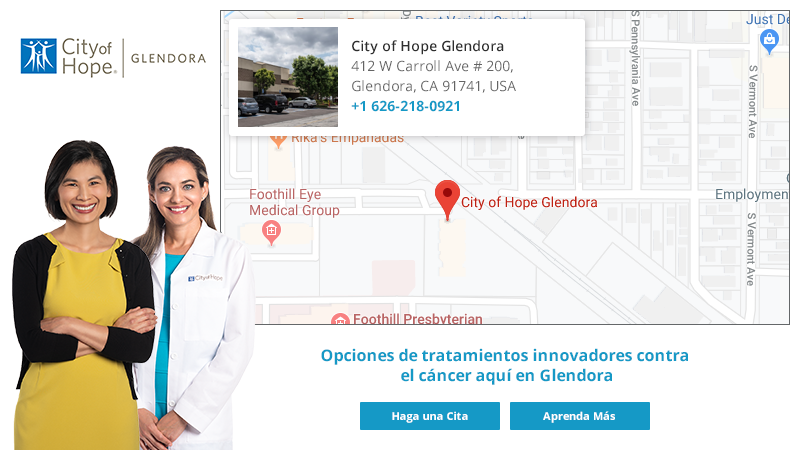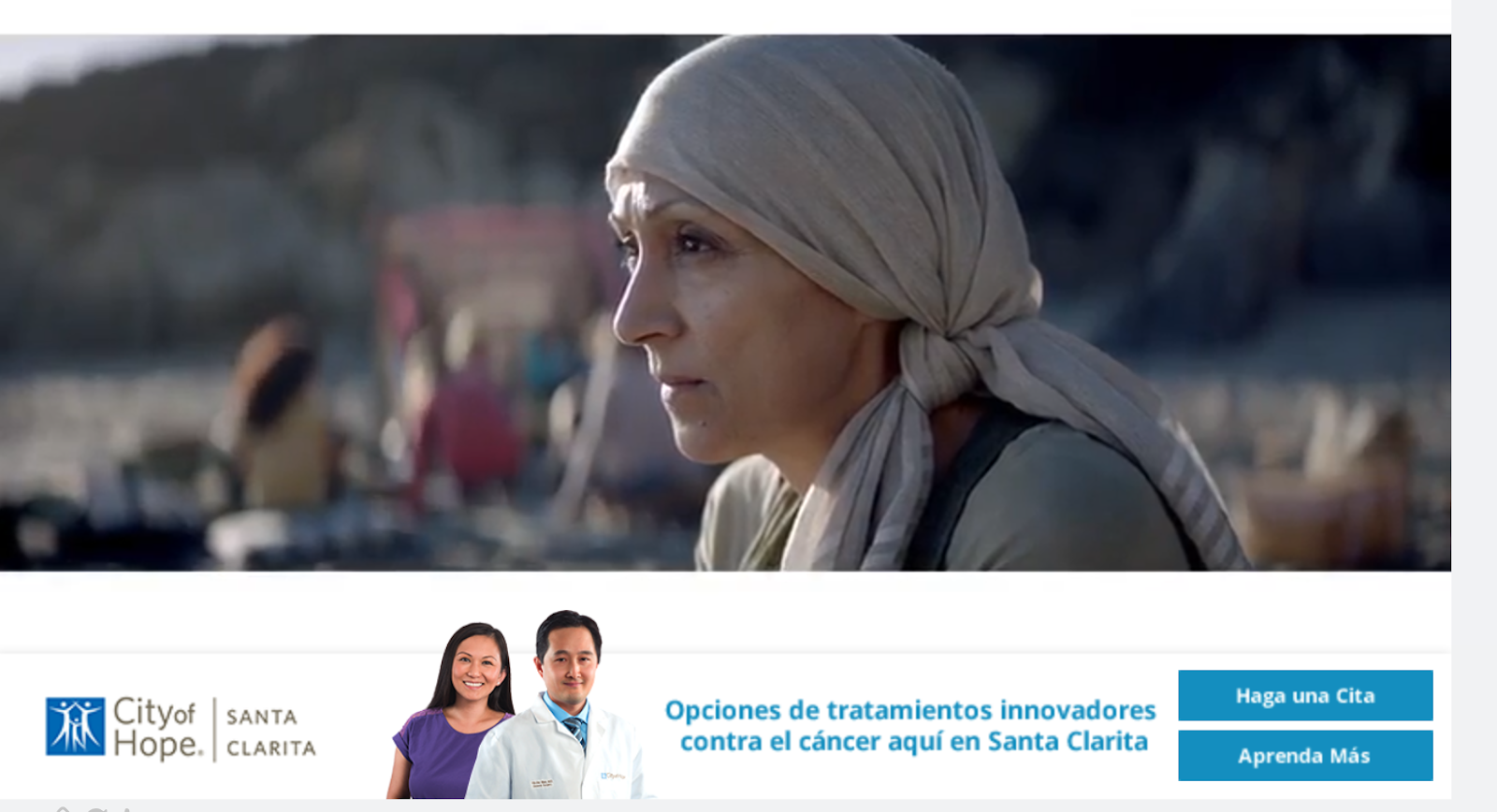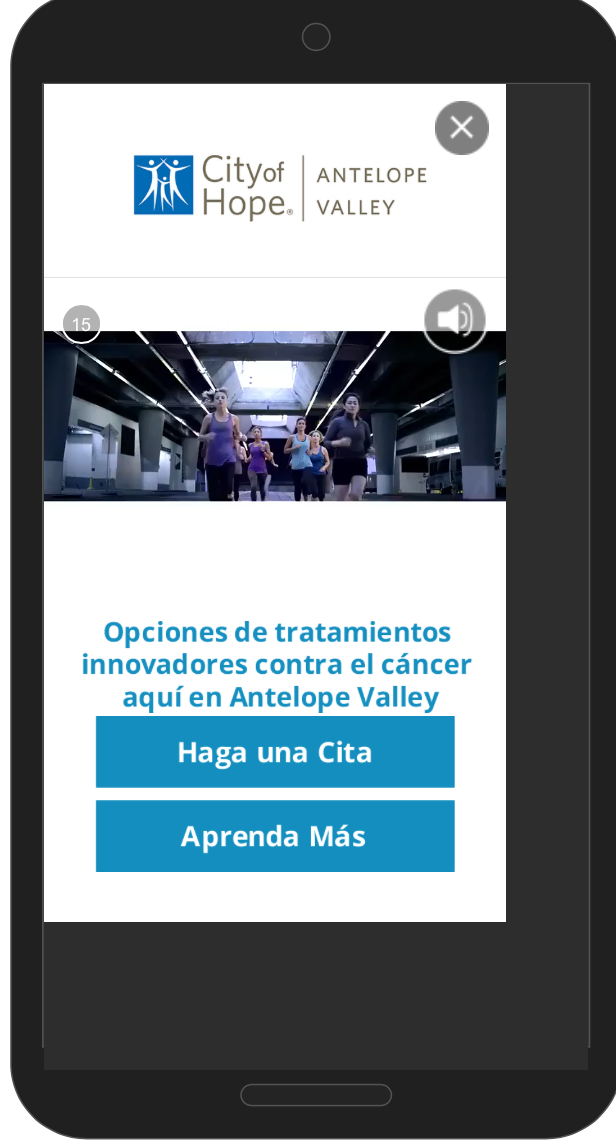City of Hope Case Study
City of Hope is a National Cancer Institute-designated comprehensive cancer center and a founding member of the National Comprehensive Cancer Network, making it a national leader in advancing research and treatment protocols. It also hails the title of one of the nation’s “Best Hospitals” in cancer by US News & World Report for over a decade.
With those incredible accolades being said, the institution wanted to reach as many potential patients as possible in order to spread awareness of their groundbreaking cancer services and resources -- specifically, their target goal was to have new patients call to make an appointment at one of their City of Hope five locations in the greater Los Angeles area. City of Hope’s marketing team had already begun their efforts by serving their pre-roll video advertisements to broad audiences -- but as their campaign played out, they came across a problem they were unsure how to solve.
Because their marketers were serving their pre-roll ads to a wide audience, the issue wasn’t a lack of viewer interaction, but more so, the wrong viewer interactions. By this we mean new patients were calling to make appointments, just as City of Hope wanted, but they were calling City of Hope locations that were out of reach for them. It is important to note here that there are five City of Hope cancer center locations throughout California and without any specifications of this presented on their ads, viewers were calling from all over California with no actual knowledge of their proximity to a City of Hope location, if any at all.
So the problem at hand was, how do we serve our ads specifically to audiences in proximity to our hospital locations so that we can achieve our goal of reaching new eligible patients in the area? And how do we do this with one single pre-roll video so we don’t have to make five separate video ads?
Luckily, our client came to the right video shop as we were able to provide a solution to their advertising problem: Geotargeting presented via our Emerging Formats, specifically our Overlay and End Card formats.

Emerging Formats Featuring Geotargeting
Starting with the initial issue, we wanted to prioritize geotargeting for our client. Geotargeting is a way for advertisers to specify the location or radius they want their ads shown. With this, advertisers can also serve different content on their ads based on the geographic location the ad will be served. This is a popular tactic with advertisers when advertising local prospects.
Given that City of Hope had multiple hospital locations, such as Pasadena, Corona, West Covina, and more, this was a crucial tool to employ in order to reach the client’s goal of new patient appointments. Because this wasn’t made clear in the initial round of video advertisements placed by the institute, they were experiencing a high volume of callers outside of their available locations. Therefore, we needed to take it a step further to make sure the geotargeted demographic we were serving ads to knew on their end that there was a City of Hope near them. We accomplished this by utilizing our emerging formats. This was the best, most cost-efficient solution for all parties given the client was only looking to use one single pre-roll for five separate ads. This is an ongoing dilemma with clients looking to geotarget because typically, there are no available budgets in place to produce multiple videos at a time for each targeted area. However, the emerging formats solve this problem time and time again as they are able to equip a single pre-roll with different geo-targeted messages.
Oculu specializes in three unique emerging formats for pre-roll ads, one of which is the Overlay.
Overlay is a banner that plays on top of the given pre-roll, usually across the bottom of the frame. Typically, it adds a call to action on your ad in a non disruptive way and is most often used to give viewers important information throughout the entire ad, such as show times, sales, and other important information.
In this case, we used the Overlay format to display the location of the closest City of Hope clinic by them as well as a clickable call to action. Custom to City of Hope, we were able to create a dynamic overlay for their pre-existing pre-roll video ad that both utilized geotargeting by detecting a user’s location, directing them to the nearest City of Hope location and provided a clickable feature that read,“Make An Appointment,” in order to increase landing page visits, drive them to the nearest location, and/or make an appointment.
To tie up the ad, we ended the overlay accompanied pre-roll with another format of ours called the End Card.

The End Card is a slate that appears at the end of a pre-roll video ad. The purpose of the End Card is to provide engagement opportunities for viewers once the ad comes to an end. You can look at the End Card as an opportunity for advertisers to display important information regarding the product/service on a larger readable screen. End cards also have the ability to add fun interactive concepts to an ad.
For City of Hope, we really wanted to give viewers as many opportunities as possible to find a location near them to make an appointment. So, with the End Card, we added a geographic map that showed viewers the proximity of the nearest City of Hope near their current location as well as the aforementioned clickables, for optimal CTR opportunities. And both the Overlay and the Endcard, working together, led to a surge in appointments made!
And just like that, we had a functioning solution!
Creating the Ads
Now that we had a solution, we were able to have a little fun in the creative process of making the actual ad. During our brainstorming while looking at the parameters of the technology, we came up with some really great ideas that we luckily were able to execute.
Since we were geotargeting five different locations with a single pre-roll, we wanted to personalize it in a way that was unique to each location. We decided to accomplish this by adding a photo of the primary doctors from each location so that potential clients could feel connected to the clinic and who would be providing them care. Each Overlay and Endcard had a photo of the actual doctor from the specific location the viewer was near. Below you will see this in effect for the Santa Clarita ad, the Santa Clarita City of Hope doctor pictured on the right:
To accomplish this, the client provided all of the images for each location as well as the pre-roll video we were to work with. From here, we took the raw images of their doctors and added them into our EndCard and Overlay designs. And from these two raw assets, we were able to create the graphics, stitch everything together, and ultimately create an emerging formatted ad that met all their needs.
But there was another targeted aspect we still had to cover. For this particular campaign, City of Hope wanted to target hispanic males as the primary demographic, aside from geotargeting. To help our client reach the aforementioned demo, we decided to run their ad in both english and Spanish. As part of the creative process of building the emerging format, we translated all of the english versions to Spanish, making them accessible to both english and spanish speaking demographics.
And with the statistics that show most viewers see content on their mobile devices, we wanted to make sure that City of Hope’s campaign would be mobile friendly as well, for ultimate results. Off the bat, the ads we created for our client worked perfect for desktop viewing, but wasn’t ideal for mobile devices. To complete our work for our client, we went the final stretch and made an additional mobile solution for the above ad as well! You can see an example of that below:

Here, the ad was transformed to fit a vertical screen. The Overlay and End Card were still attached, but formatted in a way that was mobile friendly and still clickable!
At the end of this process, we were really happy with our work and so was our client!
Targeting (Geo-targetting)
Though targeting is important in every ad campaign and can vary from specific to broad audiences, the City Of Hope’s goal specifically was to target Hispanic adults aged 25-54 dealing with cancer or caring for a family member with cancer in Los Angeles with PPO health insurance. Pretty specific, but doable!
In order to reach this target group, we utilized the aforementioned geotargeting, setting up a 5 mile radius of all City of Hope locations while simultaneously using a Zip Code list. This way, we can serve viewers within the radius the ad of their nearest City of Hope location and anybody outside the radius will still receive the ads, but they will be location generic.
We also hit our client’s targeted audience by implementing contextual and behavioral targeting, with list matching, data layers, browsing history and online behavior, ethnicity, and language data. One specific way we targeted effectively was running both english and spanish versions of each ad, the spanish translations specifically targeting spanish-speaking males within the geographic.
All of the above and were able to uber geo target and serve the demo perfectly!
The Results
Overall, the campaign was a huge success. Starting with a single pre-roll video, an unsolved problem, but big goals, we had our work cut out for us. But, we did what we do best and found a solution to our client’s problem, that problem being the fact they only had one pre-roll video with needed granular targeting that could somehow make one ad, five separate and geo-specific ads. At the very least, our emerging formats accomplished that goal, making one video stretch as far as it could go -- solving a problem and accomplishing goals with one solution.
But let’s let the results talk!
When City of Hope came to us, their main focus was securing new client appointments, specifically getting those clients to make appointments at the right clinic location. And since that was their main focus, it was also ours. And we achieved that… and much more!
After running the ads we created with our emerging formats and targeting, the campaign showed an increase in online appointments by over 78%. ( this was compared to the same media spend vs. a display campaign during the same time frame. This is not a perfect apples to apples / A/B test but the data showed that appointments were being made and patients were booking in the correct locations after seeing our ads).
One of the most engaging aspects of our emerging formats, are the clickable features. With that, we expected an increase in CTR...and our expectations were met! We saw an average CTR of .71% (just under 1%!), which was an awesome additional benefit to the campaign.
Furthermore, out of all the ads, the Santa Clarita targeted ad performed the best with a VTR of over 73%, meaning that 73% of viewers stayed on the End Card through its entirety! This is a big number!
Another interesting yet awesome data point we discovered while running this campaign was that there were more clicks on the Overlay portion of the ad than the End Card portion of the ad. In most other cases, when we run campaigns with both an Overlay and an End Card, we see more clicks on the End Card vs. the Overlay. However, with City of Hope’s campaign, we saw the exact opposite response as users seemed to click on the Overlay far more often than the End Card. We can assume that this may have been due to the specific location being geo targeted properly and efficiently!
One thing we took away from this case study was the power of our emerging format technology and targeting capabilities. Not only were we able to solve our client’s problem, but we were able to simultaneously increase viewer interactions via CTR, getting them the new patient appointments they wanted!
We pride ourselves on finding the best solutions for our clients and exceeding industry expectations and we did just that. This goes to show that no matter the roadblock, Oculu is capable and eager to overcome it.


